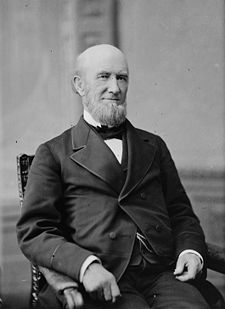James Eads
| James Buchanan Eads | |
|---|---|

James Buchanan Eads
|
|
| Born |
May 23, 1820 Lawrenceburg, Indiana |
| Died | March 8, 1887 (aged 66) Nassau, Bahamas |
| Nationality | American |
| Occupation | Civil engineer |
| Spouse(s) |
Martha Nash Dillon (m. 1845–52) Eunice Hagerman Eads (m. 1854–87) |
| Children | Two daughters, one son, three step-daughters |
| Awards | Albert Medal (1884) |
Captain James Buchanan Eads (May 23, 1820 – March 8, 1887) was a world-renownedAmerican civil engineer and inventor, holding more than 50 patents.
Eads was born in Lawrenceburg, Indiana, and named for his mother's cousin, future President of the United States James Buchanan. Eads' father, Thomas C. Eads pursued a fortune to no avail and the family moved several times. Eads grew up in St. Louis, Missouri. The family lost all of its possessions in a steamboat fire as they landed in St. Louis in 1833. Thomas Eads' business ventures in St. Louis failed, and he abandoned his family and moved upriver.
James Eads was largely self-educated; at the age of 13, he left school to take up work to help support the family. He sold apples on the streets of St. Louis to help support his sisters and mother, who ran a boardinghouse. One of his first jobs was at the Williams & Duhring dry-goods store run by Barrett Williams. Williams allowed the young Eads to spend time in his library, located above the store. In Eads's spare time, he read books on physical science, mechanics, machinery, and civil engineering. When Eads became successful later in life and Williams suffered hardship, Eads reciprocated Williams' generosity by providing money for Williams' comfort in his old age.
Around 1842, Eads fell in love with Martha Dillon, a woman related to him by marriage. Martha's father was Patrick Dillon, a prominent St. Louis businessman. Patrick did not approve of the couple, as he wanted Martha to marry someone with money and influence. In October 1845, James and Martha wed without her father's consent.
Martha moved in with Eads' parents in LeClaire, Iowa while Eads stayed behind in St. Louis to set up a glass works. Although their living arrangement was supposed to be temporary, the failure of his glass business made it permanent. Eads had many debts to pay off from the failed business and he went back to working in salvage.
...
Wikipedia
